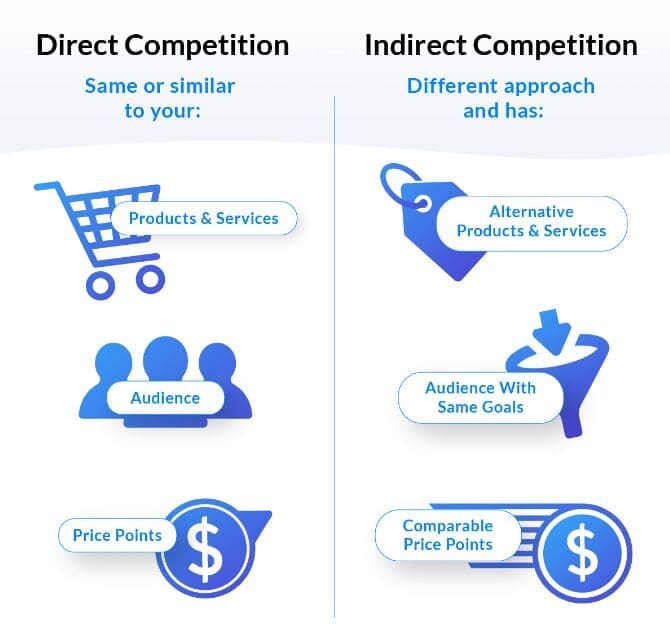Analysis 101: Make your competitors work for you!
Competition reveals opportunities for improvement. The richer the available market intelligence, the more you can learn about your niche before starting your business or deciding what to change. Following your competitors, learning their strategy and tactics, and checking their updates allows you to study the market with minimum risks and make your product even better.
Table of Contents
How can your competitors actually help you?
Competitor analysis generates useful and tangible results. As you create a competitive picture, you see the as-is situation on the paper (or rather a screen). Let’s take a look at only a few of the aspects where your competitors can come in handy. You will be able to:
- See who your potential customers are (as you investigate competitor markets and social media profiles)
- Learn what customers in your niche need (by reading their reviews)
- Identify what customers in your niche like and dislike (again, reviews)
- See what differentiates you from your competitors (as you perform analysis you start noticing things that didn’t seem so obvious before)
- Grasp ideas for new features (as you look at your product from new, different angles)
- Test similar products to yours on your own (personal experience always exposes new ideas)
- Define what you would like to bring to your product and what you’d like to avoid (the latter is especially useful—you definitely would like not to repeat your competitors’ mistakes.
…and many more, depending on the market you’re operating in.
But how do you start the analysis itself?
Which competitors to select?
First and foremost, you should choose specific competitors to analyse. If your niche is quite narrow and you personally know the CEO of each of your competitors–perfect. But frequently there are so many companies that it is difficult to figure out which of them is the best option to compare. As you select competitors for analysis, you can pay attention to two main groups: direct and indirect.
Let’s take a closer look at both groups. How does each of them actually help your business?
Direct
Direct competitors are those who offer a very similar product to yours, in the same market and therefore try to satisfy customers’ goals with a similar means.
They can help you to figure out specific features you can develop on top of your current proposition, you can be inspired by their UX and Marketing strategy. Basically, they can be very similar to you. However, it’s important to figure out why you think they don’t satisfy all customers’ needs. What’s missing in their product? Do you have any idea how to make it better? Still, don’t forget to look at what they do really well and acknowledge it, without simply being a “me too” player. How do they engage their customers? Why do their clients stay with them?
Indirect
Indirect competitors are those whose audience has the same goal, but an approach to satisfy this goal is different.
And they can also help you—you can find out some unusual techniques to resolve your customers’ pain points. Looking at indirect competitors is like searching for a solution outside the box–something unique, fresh, and unusual. Most likely, you won’t like to adopt their main features, but there may be something about their discourse, billing methods, or profile management that makes using their product especially pleasant. Try to look “between the lines” as well as directly at their (lines) features and see, what can breathe fresh air into your product?

We recommend taking 2-4 direct and 2-4 indirect competitors to create a comprehensive analysis. You can select companies of different ages and levels to track how the development in your niche occurs. Having selected the list of competitors to analyse, you can move on to the analysis itself. Let the fun begin!
Competitor analysis: step-by-step
There is a list of items you can go through while performing competitor analysis to make it truly comprehensive:
- Step 1: Company-specific. Find out the basic details about your competitor: who is the CEO, when it was founded, and what is the served market or industry.
- Step 2: Product-specific. Here you go to the most interesting part–a comparison of product features, pricing, and strong and weak points. Here is where you can reveal a broad range of new ideas.
- Step 3: Marketing strategy. Assess social media presence, customer review listings, events, and customer resources that your competitors publish.
- Step 4: Positioning. Uncover messaging that your competitors promote to their audience.
If you can see all of the selected competitors analysed side-by-side, in one row of a spreadsheet, for example, you immediately catch the main difference between them. Compare them not only to your product but also to one another. Do you think there is one leader among them? Why? Do you think they react to each other’s updates and how?
Let’s also discuss approaches you can use to perform analysis.
- Study website. Perhaps, the first point of contact and way to hear exactly what your competitors want their customers to hear. Assess usability, find out what features they offer, what the pricing is, and what additional materials they have.
- Test product. Few things can be better than own experience. It’s not always possible to actually try the product for free, but if there is such an option—do not hesitate to try.
- Read reviews. Honest feedback left by actual users is gold. Pay attention to comments with different ratings, especially the ones of 3-4 stars out of 5. This happens when people are generally satisfied with the main features but are unhappy about some non-functional aspects, such as speed or design. Learn what bothers people the most.
- Check social media. Both company page and top-level management pages can be useful. Also, don’t hesitate to follow them to keep track of the updates they make.
- Read available company data. Other people most likely already studied your competitors and posted something about them. You can find public data on the company’s funding, investors, revenue, press releases, and many more. Just Google it!
- Read support documentation. Docs can frequently explain more than you expect. Read about features, product structure, roles matrix, and more.

What's next?
A comprehensive competitor analysis once compiled gives you a solid understanding of the market situation, as well as the ability to maneuver when adopting changes.
Where you can use the results of competitor analysis:
- When creating personas. Study customer reviews to get acquainted with real human profiles, who have the very need you are going to meet.
- When performing market research. Learn what types of businesses you can target based on who your competitors sell to.
- When defining features to develop. See what your competitors offer and figure out what you can incorporate into your product to increase its value.
- When prioritising features. Find out how many competitors offer each feature and analyse if and how much it is needed.
- When planning a marketing strategy. See how often you should post and share to stay competitive and in touch with your audience.
- When defining pricing. How much do your direct competitors charge for their products? Compare this data to the number of features you offer to gain a general view of your product’s pricing.
- And more!
If you wish to access a comprehensive step-by-step guide on how to perform competitor analysis and how to group the found data, just leave your email and access it for free.
It is nice to have valid competition; it pushes you to do better.
Gianni Versace
If you’re still not sure which competitors to select and how to extract maximum value for your company, do not hesitate to contact us. Fractional Teams can help you with the compilation of competitor analysis for your business.
Solomiia Bodnar
Hi! I'm Solomiia Bodnar, Senior Business Analyst at Fractional Teams. I write about market research and business analysis.
